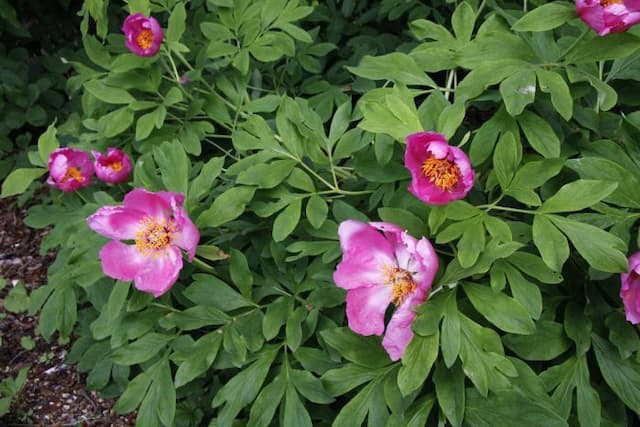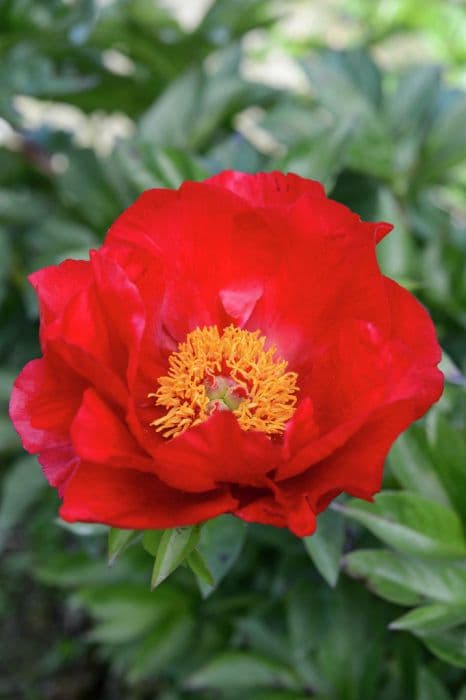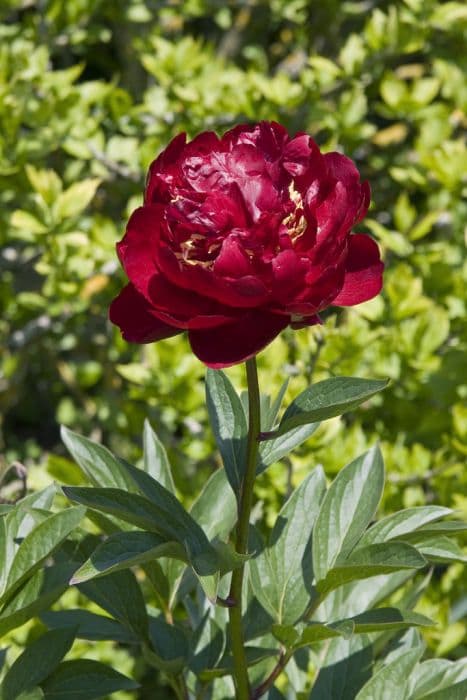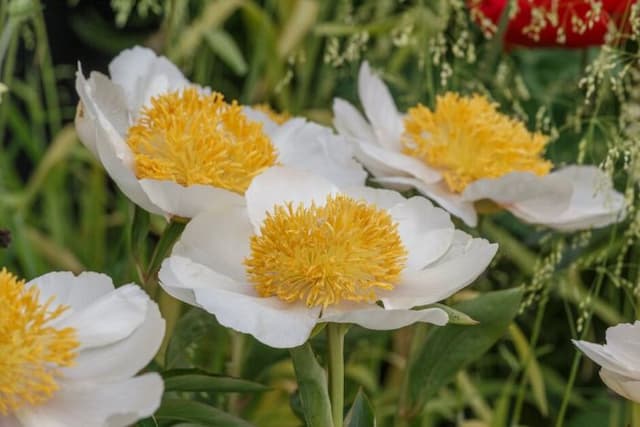Peony Paeonia 'Court Jester'

ABOUT
The Paeonia 'Court Jester' is a variety of Peony that produces striking flowers. The blooms are notable for their unique coloration and pattern. Each flower consists of petals that are a blend of cream and pink. These petals are often streaked or edged with deeper pink to magenta hues, creating a playful and somewhat whimsical appearance, reminiscent of a jester's attire. This multicolored effect gives the plant a charming and attractive look that can easily become the centerpiece in a garden display. The flowers are large and showy, typically presenting a fluffy, full appearance due to the volume of the petals, which may have a silky or satiny texture. The foliage of the 'Court Jester' Peony is also a feature that complements its beautiful flowers. The leaves are a deep green color, providing a lush backdrop that makes the flowers stand out even more. They are typically divided into leaflets with a shiny surface that can catch the light, further enhancing the visual impact of the plant. Peonies, including the 'Court Jester' variety, are known for their durability and longevity. They are perennials, meaning they will return year after year with the proper care. Over time, the clump of the plant will become more substantial, producing more of its distinctive blooms each spring or early summer. The flowers of the 'Court Jester' Peony, with their delightful color play and large size, are not only loved by gardeners but are also highly attractive to pollinators such as bees. Their pleasant fragrance is an additional characteristic that makes this plant a coveted addition to any garden.
About this plant
 Names
NamesSynonyms
Peony, Garden Peony
Common names
Paeonia 'Court Jester'
 Toxicity
ToxicityTo humans
The Paeonia 'Court Jester', commonly known as peony, is generally considered non-toxic to humans. However, sensitive individuals may experience mild gastrointestinal upset if they ingest parts of the plant. It is uncommon for peonies to cause severe poisoning in humans.
To pets
Peony, including the Paeonia 'Court Jester', can be toxic to pets if ingested. The poison is found in all parts of the plant, but it is more concentrated in the seeds and roots. Symptoms of peony poisoning in pets might include vomiting, diarrhea, and lethargy. In severe cases, pets could experience convulsions or enter a coma. It is essential to keep peonies out of reach of pets and to seek veterinary care if you suspect your pet has consumed any part of the plant.
 Characteristics
CharacteristicsLife cycle
Perennials
Foliage type
Deciduous
Color of leaves
Green
Flower color
Mixed
Height
2-3 feet [60-90 cm]
Spread
2-3 feet [60-90 cm]
Plant type
Shrub
Hardiness zones
3-8
Native area
Asia
Benefits
 General Benefits
General Benefits- Ornamental Appeal: Adds aesthetic beauty to gardens with its colorful and vibrant flowers.
- Seasonal Interest: Blooms in spring, providing seasonal interest in garden landscapes.
- Durability: A hardy perennial that can survive in a range of soil conditions and climates.
- Low Maintenance: Typically requires minimal care once established, apart from occasional watering and fertilizing.
- Attracts Pollinators: Flowers attract bees, butterflies, and other beneficial insects, supporting local ecosystems.
- Versatility: Can be used in a variety of garden settings, including borders, flower beds, and as a focal point.
- Cut Flowers: Blooms make excellent cut flowers for arrangements due to their attractiveness and longevity.
- Deer Resistance: Less palatable to deer, reducing the likelihood of damage in areas with deer populations.
 Medical Properties
Medical PropertiesThis plant is not used for medical purposes.
 Air-purifying Qualities
Air-purifying QualitiesThis plant is not specifically known for air purifying qualities.
 Other Uses
Other Uses- As a dye source: The petals of Peony 'Court Jester' can be used to make a natural dye for fabric, offering shades of pink or light red depending on the mordant used.
- In perfumery: The fragrant blooms of the Peony can be used in the creation of perfumes, providing a floral note to fragrance blends.
- As a flavoring: Peony petals, though not commonly used, can be infused into syrups or sugars to impart a subtle floral flavor to desserts and beverages.
- For photography: The striking blooms of Peony 'Court Jester' are often used by photographers as subjects or backdrops for their botanical and still-life photography.
- In crafts: Dried Peony petals can be incorporated into paper making or used for potpourri, adding both color and a mild fragrance.
- As an ornamental ice bowl: Frozen Peony blossoms can be embedded in ice to create decorative bowls for chilling beverages during fancy events.
- For educational purposes: Botany students may study the Peony 'Court Jester' to learn about plant morphology and hybrid plant development.
- In cultural festivals: The Peony is often used in cultural celebrations and depicted in artworks, especially in Asian festivals where it symbolizes prosperity and happiness.
- As cut flowers: Peonies, including 'Court Jester', are popularly used in floral arrangements and bouquets due to their large, showy blooms and longevity in vases.
- For culinary decoration: While not a traditional edible flower, Peony petals can be used to garnish plates and add a touch of elegance to special dishes.
Interesting Facts
 Feng Shui
Feng ShuiThe peony is often used in Feng Shui to promote love and romance, as well as good fortune and prosperity. It can be placed in the southwest corner of a garden or room to enhance relationships and invite positive chi related to companionship and wealth.
 Zodiac Sign Compitability
Zodiac Sign CompitabilityThe peony is not used in astrology practice.
 Plant Symbolism
Plant Symbolism- Wealth and Prosperity: Peonies, including the Court Jester variety, are often associated with wealth and prosperity due to their full, rounded blooms.
- Honor and High Status: Historically, peonies have been valued by the Chinese nobility, symbolizing honor and high social status.
- Beauty: Their lush petals and vibrant colors make peonies a symbol of beauty in various cultures.
- Romance and Marital Happiness: Peonies are widely used in wedding bouquets and decorations as they represent happy marriages and romantic relations.
- Compassion: The delicate appearance of peony flowers can evoke feelings of compassion and thoughtfulness.
- Good Fortune: Peonies are considered good luck charms that attract positive fortunes and ward off negative energies.
 Water
WaterPeonies like 'Court Jester' prefer consistent moisture throughout the growing season, particularly during dry spells. Water the plant once a week with about 1 inch of water, which equates to roughly 0.6 gallons per square yard if using a garden hose or watering can. Ensure that the soil is well-drained to prevent waterlogging, as peonies do not like standing water around their roots. During hot and dry periods, increase watering frequency but always check the soil moisture before watering. In the fall, reduce watering to help the plant harden off for winter.
 Light
LightPeonies, including 'Court Jester', thrive in full sun to partial shade. Ideally, they should receive a minimum of six hours of direct sunlight each day. Placing them in a location that gets morning sunlight and some afternoon shade is optimal to protect the blooms from the harsh afternoon sun.
 Temperature
Temperature'Court Jester' peonies prefer temperate climates and are hardy in a range of conditions. They can tolerate winter temperatures as low as -20°F and are most comfortable in growing zones with winter temperatures not consistently below this range. The ideal temperature for robust growth and flowering is between 65°F and 75°F during the growing season.
 Pruning
PruningPrune 'Court Jester' peonies after flowering to remove spent blooms, which encourages the plant to put energy into root and foliage development instead of seed production. In the fall, after the first frost, cut back the foliage to within a few inches of the ground to help prevent disease and to tidy up the plant before winter. Pruning is generally done annually.
 Cleaning
CleaningAs needed
 Soil
SoilPeony 'Court Jester' thrives in well-draining soil enriched with organic matter. A blend of two parts garden soil, one part compost or well-rotted manure, and one part perlite or coarse sand is ideal. Soil pH should be neutral to slightly alkaline, between 6.5 and 7.5.
 Repotting
RepottingPeonies like 'Court Jester' are long-lived perennials and do not need frequent repotting. They should be transplanted or divided every 10 to 15 years, or when clumps become too crowded and flowering diminishes.
 Humidity & Misting
Humidity & MistingPeony ‘Court Jester’ fares well in average outdoor humidity levels and does not require any special humidity conditions.
 Suitable locations
Suitable locationsIndoor
Provide bright light, cool temps, and plant in well-draining soil.
Outdoor
Plant in sun or part-shade, enrich soil, water regularly.
Hardiness zone
3-8 USDA
 Life cycle
Life cyclePeony 'Court Jester' begins its life cycle as a dormant tuberous root that breaks dormancy in early spring when soil temperatures rise. The plant then sends up shoots, which develop into stems and leaves, forming a bushy herbaceous perennial. By late spring to early summer, 'Court Jester' produces large, colorful, and often fragrant flowers that attract pollinators and may be used for ornamental cuttings. After flowering, the plant sets seed in the form of a capsule if pollination occurs; these seeds can be collected for propagation or allowed to disperse naturally. Throughout the summer, the peony's foliage remains lush, providing aesthetic value until it begins to yellow and die back as temperatures cool in fall. The plant then enters a period of dormancy over the winter, conserving energy in its root system to restart the cycle the following spring.
 Propogation
PropogationPropogation time
Spring-Early Summer
The Paeonia 'Court Jester', more commonly known as the peony 'Court Jester', can be propagated through division, which is the most popular method for this perennial plant. Propagation by division is ideally done in the fall after the plant has finished blooming and begins to go dormant. To propagate by division, carefully dig up the peony clump, making sure to minimize damage to the roots. The clump should then be divided into sections, ensuring each section has at least three to five eyes, which are the potential growth points for new shoots. The divisions are then replanted in well-draining soil at a depth where the eyes are approximately 2 inches (about 5 centimeters) below the surface. This allows for adequate root development while still exposing the eyes to enough warmth from the sun for proper growth. After planting, watering thoroughly helps settle the soil around the roots and initiates the growth process for the following spring.









